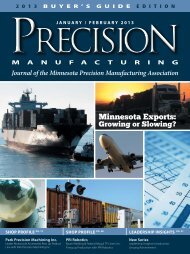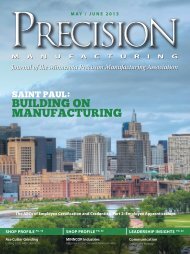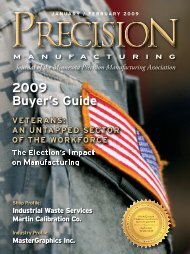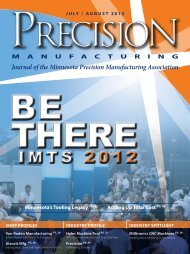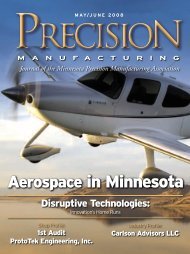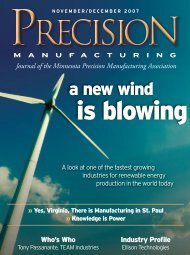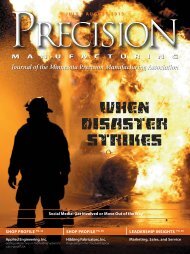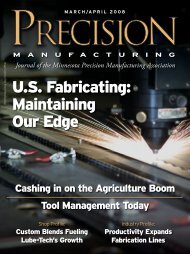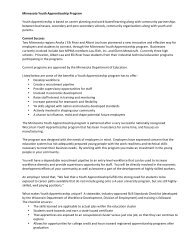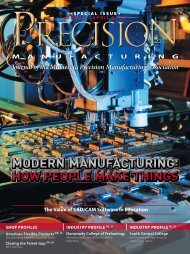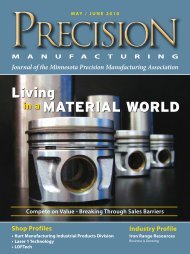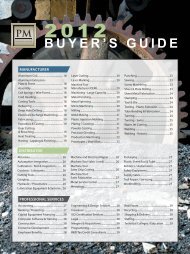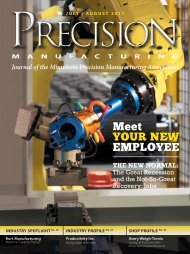MTConnect: Different Devices, Common Connection Changing ...
MTConnect: Different Devices, Common Connection Changing ...
MTConnect: Different Devices, Common Connection Changing ...
You also want an ePaper? Increase the reach of your titles
YUMPU automatically turns print PDFs into web optimized ePapers that Google loves.
INDUSTRY PROFILE: ENGINEERED FINISHING CORP.<br />
The first step for minimizing is<br />
to reduce the costs for individual<br />
finishing and roughing passes for the<br />
various depths of the cut. Considered<br />
in the next step is the combination of<br />
depths of the cut for the finishing and<br />
roughing passes. Depth of cuts, along<br />
with an optimal number of passes,<br />
are combined with the stepover path<br />
distance to minimize run times and<br />
cost. The stepover value determines<br />
whether the surface finish on a<br />
component is rough or smooth.<br />
For example, when using a<br />
flatbottomed tool such as an end<br />
mill, the stepover value is normally<br />
around 70 percent of the cutter<br />
diameter in combination with depth,<br />
feed, and speed rates. Raster passes,<br />
radial passes, spiral passes, morph<br />
passes, and boundary passes are the<br />
methods of choice for true surface<br />
machining. Allocating expensive CNC<br />
machine time for cleanup and surface<br />
finishing should be considered overprocessing<br />
and costly when measured<br />
in machine time (throughput dollars)<br />
and the achieved results. Abrasive Flow<br />
Grinding (also known as abrasive flow<br />
machining) is a cost effective machining<br />
process for finishing and polishing a<br />
surface, including difficult-to-reach<br />
surfaces and internal passages.<br />
The Abrasive Flow Grinding process<br />
involves three principle elements: a<br />
tooling fixture, the machine, and the<br />
abrasive. The typical Abrasive Flow<br />
Grinding process uses two opposing<br />
cylinders to push the media in two<br />
directions, i.e., back and forth with a<br />
controlled flow pressure. Tooling is<br />
used to direct the media flow across the<br />
surface of the part and through internal<br />
passages and intersecting passages. Flow<br />
grinding action occurs wherever the<br />
media comes in contact with a surface.<br />
The flow pressure as well as the number<br />
of finishing cycles (back and forth media<br />
grinding/flow) are controlled.<br />
A workpiece fixture is used to hold<br />
a part or multiple parts for processing.<br />
The fixture directs and controls the<br />
volume and pressure of media flow<br />
across surfaces and through internal<br />
passages. Lightweight fixtures are placed<br />
on and removed from the lower media<br />
Figure 3<br />
cylinder by the machine operator. The<br />
lower media cylinder (the processing<br />
station) is located in the center of the<br />
worktable. Higher production and/<br />
or heavier fixtures can be positioned<br />
automatically from the loading station to<br />
the processing station by a hydraulically<br />
actuated dual fixture rotary table. In the<br />
way of increasing throughput dollars,<br />
flow grinding reduces other costs by<br />
reducing and/or eliminating handwork<br />
that may not be as uniform, repeatable,<br />
or predictable.<br />
The flow grinding media is made of<br />
a flowable polymer carrier mixed with<br />
one or more sizes of abrasive grain. The<br />
media viscosity range is from a soft,<br />
almost grease-like consistency, to a firm,<br />
putty-like material consistency. With<br />
a pure grinding and polishing backand-forth<br />
type of action, the grinding/<br />
abrasive media flows across surfaces<br />
or through internal passages to refine<br />
surfaces and edges.<br />
The most commonly used abrasives<br />
are silicon carbide and aluminum oxide.<br />
These provide a good balance between<br />
high performance and moderate cost.<br />
Typically, the particle sizes of abrasives<br />
used range from a coarse 20 mesh<br />
abrasive (average particle size ~0.9<br />
mm) to a very fine 600 mesh abrasive<br />
(average particle size ~0.9 microns).<br />
Abrasive media will contain around 25<br />
percent up to around 67 percent, by<br />
weight of the abrasive grain.<br />
Abrasive Flow Grinding has helped<br />
us achieve polished and lapped external<br />
and internal passages characterized by<br />
their measured Ra values. Tools that are<br />
used together can help to reduce waste<br />
as measured in throughput dollars and<br />
over processing. All production practices<br />
promote the reduction of waste,<br />
reduction of over-processing, and the<br />
control of flow for increasing throughput<br />
dollars. The benefits of milling a finished<br />
surface probably are not worth the cost.<br />
Several examples of surface finishes we<br />
have accomplished with abrasive flow<br />
grinding are shown below.<br />
September | October | 2012 2012 PRECISION MANUFACTURING | 19| 19




